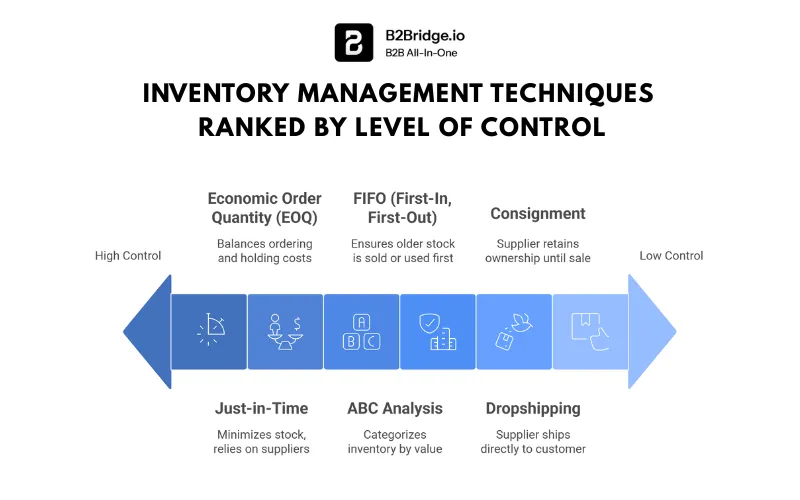Inventory management is the process of overseeing the ordering, storage, tracking, and control of inventory from procurement through sale or production. According to industry research, businesses that implement structured inventory management systems can reduce carrying costs by up to 25% while improving order fulfillment rates significantly. For retailers, poor inventory management leads to an estimated $1.1 trillion in losses globally due to overstocking and stockouts combined.
This comprehensive guide explores everything you need to know about inventory management: from fundamental concepts and proven techniques to cutting-edge technologies and real-world success stories.
In this article, we will guide you through:
- What is Inventory Management?
- How to calculate inventory management
- Importance and Benefits of Inventory Management
- Common Inventory Management Techniques
- Inventory Tracking and Technologies
- Best Practices for Effective Inventory Management
- Case Studies and Examples
- Challenges in Inventory Management and How to Solve Them
- Emerging Trends in Inventory Management
What is Inventory Management?
Definition
Inventory management is the systematic approach to sourcing, storing, tracking, and controlling inventory throughout its lifecycle. It encompasses the entire journey of goods – from the moment raw materials are ordered through production processes and ultimately to the delivery of finished products to customers.

Whether you’re just starting to formalize your inventory processes or looking to optimize existing systems, you’ll find actionable insights to transform how you manage stock and drive better business outcomes.
At its core, inventory management answers critical business questions: What should we order? How much should we stock? When should we reorder? Where should inventory be positioned? The answers directly influence cash flow, storage costs, production efficiency, and the ability to meet customer demand without delay.
Types of Inventory
Effective inventory management handles several distinct types of inventory, each requiring different strategies:
Raw Materials: These are the basic components and materials purchased for production. For a furniture manufacturer, this includes wood, fabric, hardware, and finishing materials. Managing raw materials ensures production lines never halt due to shortages while avoiding excessive capital tied up in unused supplies.
Work-in-Progress (WIP): This represents partially completed goods currently in the production process. WIP inventory includes all materials, labor, and overhead costs invested in items that aren’t yet finished. Monitoring WIP helps identify production bottlenecks and ensures efficient use of manufacturing resources.
Finished Goods: These are completed products ready for sale or distribution. For retailers, this constitutes the majority of inventory. For manufacturers, finished goods await shipment to distributors, retailers, or end customers. Balancing finished goods inventory prevents both disappointing stockouts and costly overstock situations.

How does Inventory Management work?
Inventory management works through a series of interconnected processes designed to track and control inventory efficiently. It starts with counting the existing stock, either through physical counts or automated tracking systems. When inventory reaches predetermined minimum levels, new orders are placed with suppliers. Upon delivery, items are received, inspected for quality, recorded, and stored in designated locations for future production or sales.
Many of these steps are automated using inventory management software that integrates demand forecasts, procurement data, production schedules, and warehouse information. Technologies like barcode scanners, cloud platforms, and Internet of Things devices facilitate real-time tracking and help identify inefficiencies quickly.
The core steps in inventory management include:
- Counting current inventory and demand forecasting to anticipate future needs
- Establishing reorder points to trigger replenishment
- Ordering and receiving products, followed by inspection and quality control
- Recording and storing inventory in an organized manner
- Tracking inventory movements and sales through automated systems
- Using ongoing analysis and reporting for optimization and decision making
For businesses operating in the B2B space, inventory complexity multiplies as you manage different price lists, customer segments, and order patterns. Give your B2B buyers a smooth, self-serve shopping journey with systems that integrate inventory visibility, accurate pricing, and streamlined ordering – creating experiences that rival B2C ease while accommodating wholesale complexity with B2Bridge.io.
How to Calculate Inventory Management
Inventory management calculation involves various methods to quantify and value inventory accurately. Key formulas and methods include:
Inventory Valuation:
Inventory value can be calculated by multiplying the quantity of items in stock by their purchase cost.
For valuation, methods include:
- First-In, First-Out (FIFO): Assumes items purchased first are sold first, so inventory is valued at the most recent purchase prices.
- Last-In, First-Out (LIFO): Assumes the most recently purchased items are sold first, so inventory is valued at older purchase prices.
- Weighted Average Cost (WAC): Calculates an average unit cost by dividing the total cost of inventory available by total units available.
- Specific Identification: Tracks the exact cost of individual inventory items, useful for uniquely identifiable products.
Common Inventory Management Formulas:
COGS = Beginning Inventory + Purchases − Ending Inventory
Sell-Through Rate (measures sales efficiency):
Sell-Through Rate = (Units Sold / Units Received) × 100
Days’ Sales of Inventory (DSI) (measures average time inventory is held):
DSI = (Ending Inventory / COGS) × 365
Economic Order Quantity (EOQ):
EOQ calculates the optimal order quantity to minimize total inventory costs including ordering and holding:
EOQ = √(2DS / H)
where D = demand, S = ordering cost, and H = holding cost per unit.
>> You may concern: What Is B2B Product Information Management (PIM)?
Importance and Benefits of Inventory Management
Strategic inventory management delivers tangible benefits that extend across every aspect of business operations. Organizations that invest in robust inventory systems consistently outperform competitors in profitability, customer satisfaction, and operational resilience.
Improved Cash Flow and Reduced Holding Costs
Inventory represents a significant capital investment. Every dollar tied up in excess stock is a dollar unavailable for growth initiatives, marketing, or operational improvements. Effective inventory management optimizes stock levels, freeing up working capital while reducing the associated holding costs – including warehousing, insurance, depreciation, and potential obsolescence.
Studies show that businesses can reduce total inventory costs by 10-30% through better management practices. For a company with $2 million in inventory, that translates to $200,000 – $600,000 in annual savings or freed capital.
Enhanced Customer Satisfaction Through Availability
Nothing frustrates customers more than discovering their desired product is out of stock. Stockouts lead to lost sales, damaged brand reputation, and customers turning to competitors. Research indicates that 70% of consumers will switch brands if their preferred product is consistently unavailable.
Effective inventory management ensures high product availability rates, enabling businesses to fulfill orders promptly and reliably. This reliability builds customer trust, encourages repeat purchases, and generates positive word-of-mouth that drives organic growth.
Minimized Waste and Obsolescence
Poor inventory practices lead to significant waste. Products expire, go out of season, become obsolete due to technology changes, or deteriorate in storage. The fashion industry alone writes off billions annually due to unsold inventory, while food retailers face similar challenges with perishable goods.
Sophisticated inventory management incorporates demand forecasting and inventory aging analysis to identify slow-moving items before they become write-offs. By adjusting purchasing patterns and implementing targeted promotions, businesses minimize waste while protecting profit margins.
Data-Driven Decision Making
Modern inventory management systems generate valuable data revealing patterns in customer demand, seasonal variations, supplier performance, and product profitability. This intelligence empowers managers to make informed decisions about product mix, pricing strategies, promotional timing, and supplier relationships.
Analytics can reveal that certain products have higher margins but slower turnover, informing decisions about whether to maintain stock levels or focus on faster-moving alternatives. Similarly, tracking supplier lead times and reliability helps businesses identify and address supply chain vulnerabilities before they impact operations.
Operational Efficiency Gains
Streamlined inventory processes reduce time spent on manual counts, reconciliation, and correction of errors. Staff can focus on value-adding activities rather than searching for misplaced items or correcting data discrepancies. Automated reordering systems ensure timely replenishment without constant manual oversight.
For wholesale and B2B operations, efficient inventory management becomes even more critical. Run B2B as easily as B2C with B2Bridge’s all-in-one wholesale app that integrates inventory visibility directly into your customer-facing portals, reducing manual order processing and improving fulfillment accuracy.
Common Inventory Management Techniques
Different businesses require different approaches to inventory management. The following techniques represent proven methodologies that organizations worldwide use to optimize stock levels, reduce costs, and improve service levels.

Just-in-Time (JIT) Inventory
How it works: JIT inventory minimizes stock holdings by ordering and receiving goods only as needed for production or sale. This approach originated in Japanese manufacturing and gained worldwide attention through Toyota’s production system.
Appropriate use cases: JIT works best for businesses with reliable suppliers, predictable demand patterns, and efficient logistics. Manufacturing operations with consistent production schedules and retailers with fast inventory turnover benefit most.
Advantages: Dramatically reduces holding costs, minimizes warehouse space requirements, reduces waste from obsolescence, and improves cash flow by avoiding excess inventory investment.
Disadvantages: Increases vulnerability to supply chain disruptions, requires exceptional supplier reliability and coordination, offers less buffer against unexpected demand spikes, and may result in higher per-unit shipping costs due to smaller, more frequent orders.
Economic Order Quantity (EOQ)
How it works: EOQ is a mathematical formula that calculates the optimal order quantity that minimizes total inventory costs – balancing ordering costs against holding costs. The formula considers annual demand, cost per order, and annual holding cost per unit.
Appropriate use cases: EOQ suits businesses with steady demand, predictable costs, and significant ordering expenses. It’s particularly effective for products with consistent sales velocities and stable supplier relationships.
Advantages: Provides a scientific approach to determining order quantities, optimizes the balance between ordering frequency and holding costs, and reduces guesswork in purchasing decisions.
Disadvantages: Assumes constant demand and costs (which rarely hold true), doesn’t account for quantity discounts or supplier minimum orders, and may not suit products with seasonal or volatile demand patterns.
First In, First Out (FIFO)
FIFO is a widely used method where the oldest inventory is sold first – ideal for businesses handling perishable or time-sensitive products. In times of inflation, FIFO usually results in lower cost of goods sold (COGS) and higher reported profits, as remaining stock is valued at more recent, higher purchase prices.
Last In, First Out (LIFO)
LIFO assumes that the most recently purchased inventory is sold first. During inflation, it often leads to higher COGS and lower profits, which can reduce taxable income – a potential advantage in markets where this method is permitted, such as the United States.
Reorder Point (ROP)
The reorder point is the inventory level at which new stock should be ordered to avoid stockouts. ROPs can vary throughout the year based on seasonality, supplier lead times, and sales trends, so it’s important to review and adjust them regularly to maintain optimal stock levels.
ABC Analysis
How it works: ABC analysis categorizes inventory into three tiers based on value and importance. “A” items represent high-value products requiring tight control and frequent review. “B” items have moderate value with standard controls. “C” items are low-value, high-quantity products managed with minimal oversight.
Typically, items constitute about 20% of inventory but represent 70-80% of inventory value. C items might be 50% of inventory items but only 5-10% of value.
Appropriate use cases: ABC analysis works for virtually any business with diverse product ranges. It’s especially valuable for retailers and distributors managing hundreds or thousands of SKUs.
Advantages: Focuses management attention on high-impact items, enables differentiated inventory policies based on importance, improves resource allocation, and simplifies complex inventory portfolios.
Disadvantages: Requires regular reclassification as product importance changes, may oversimplify by ignoring factors beyond value (like criticality or demand variability), and needs clear policies for managing each category.
Safety Stock Calculation
How it works: Safety stock represents buffer inventory maintained to protect against stockouts caused by demand variability or supply delays. Calculations consider demand variability, lead time variability, and desired service levels.
Appropriate use cases: Safety stock is essential for businesses facing unpredictable demand, unreliable suppliers, long lead times, or where stockouts carry high costs (lost sales, production stoppages, customer dissatisfaction).
Advantages: Reduces stockout risk, maintains customer service levels during demand spikes or supply delays, and provides operational flexibility.
Disadvantages: Increases holding costs and capital requirements, can mask underlying supply chain problems, and requires accurate demand forecasting and lead time data.
Dropshipping and Consignment
How it works: Dropshipping transfers inventory holding to suppliers who ship directly to customers. Consignment allows businesses to display and sell products while suppliers retain ownership until sale.
Appropriate use cases: Dropshipping suits online retailers with limited capital or storage capacity. Consignment works for retailers wanting to expand product ranges without inventory investment, and for new or unproven products.
Advantages: Eliminates inventory carrying costs and risks, reduces capital requirements, enables rapid product range expansion, and shifts obsolescence risk to suppliers.
Disadvantages: Reduces profit margins, limits control over fulfillment quality and timing, creates dependency on supplier capabilities, and may complicate returns and customer service.
For wholesale businesses managing complex pricing across different customer segments, hide wholesale prices from retail shoppers and show the right price to the right customer with integrated systems that automate pricing rules without manual inventory updates.
Inventory Tracking and Technologies
The evolution from clipboard inventory counts to real-time digital tracking has revolutionized how businesses manage stock. Modern technologies provide unprecedented visibility, accuracy, and automation capabilities.
Inventory Tracking Methods
| Method | Description | Best For | Accuracy | Cost |
| Manual Counts | Physical counting with paper records | Very small businesses, startups | Low-Medium | Very Low |
| Barcode Scanning | Scanning printed barcodes to track movement | Small to medium businesses, retail | High | Low-Medium |
| RFID Tags | Radio frequency identification for automated tracking | Large warehouses, high-value items | Very High | Medium-High |
| QR Codes | Two-dimensional barcodes with more data capacity | Modern retail, omnichannel operations | High | Low |
| IoT Sensors | Connected devices providing real-time status | Cold chain, condition-sensitive inventory | Very High | High |
Inventory Management Software
Modern inventory management software has transformed from simple spreadsheets into sophisticated systems offering comprehensive capabilities:
Core features include real-time stock tracking, automated reorder point alerts, multi-location inventory visibility, serial number and lot tracking, demand forecasting based on historical data, and integration with accounting and sales systems.
Advanced capabilities encompass mobile accessibility for on-the-go inventory management, batch and expiration date tracking for compliance, landed cost calculations including shipping and duties, vendor management with performance metrics, and customizable reporting and analytics dashboards.
System Integration
The true power of inventory management emerges through integration with other business systems:
ERP Integration: Enterprise Resource Planning systems unify inventory with financial management, production planning, human resources, and customer relationship management. This creates a single source of truth across the organization.
POS Integration: Point-of-Sale systems automatically update inventory as sales occur, providing real-time accuracy and eliminating manual reconciliation. This integration is fundamental for multi-channel retailers.
Ecommerce Integration: Connecting inventory systems with online stores prevents overselling, enables real-time availability displays, and synchronizes inventory across all sales channels.
Cloud-Based and Real-Time Capabilities
Cloud-based inventory platforms offer compelling advantages: accessibility from anywhere with internet connectivity, automatic software updates without IT intervention, scalability that grows with your business, lower upfront costs through subscription models, and automatic backups protecting against data loss.
Real-time tracking capabilities mean that every transaction – sale, receipt, return, or transfer – immediately updates inventory records across all systems. This eliminates the lag inherent in batch-processing systems and provides accurate, current information for decision-making.
Grow your B2B channel without messy spreadsheets or manual work by leveraging integrated systems that synchronize inventory across retail and wholesale operations, ensuring accurate availability for all customer types.
Best Practices for Effective Inventory Management
Implementing the right techniques and technologies is only part of the equation. Sustainable success requires embedding best practices into organizational culture and operations.
Implement Accurate and Regular Inventory Audits
Physical counts remain essential even with sophisticated tracking systems. Schedule regular cycle counts where portions of inventory are verified on a rotating basis, conduct annual or quarterly full physical inventories, investigate and resolve discrepancies immediately, and document audit procedures to ensure consistency.
Cycle counting distributes the workload throughout the year while maintaining accuracy. High-value A items might be counted monthly, while lower-value C items are verified quarterly or annually.
Use Data Analytics and Forecasting Tools
Historical data reveals patterns invisible to intuition. Analyze sales trends across multiple timeframes, identify seasonal patterns and plan accordingly, track product lifecycle stages from introduction through decline, monitor supplier lead times and variability, and calculate inventory turnover rates to identify slow-moving stock.
Demand forecasting combines historical data with market intelligence, promotional calendars, and economic indicators to predict future requirements. Even basic forecasting significantly outperforms gut-feel ordering decisions.
Optimize Reorder Points and Stock Levels
Set reorder points that trigger replenishment before stockouts occur, considering average demand during lead time plus safety stock. Calculate optimal order quantities balancing ordering costs, holding costs, and quantity discounts. Review and adjust parameters quarterly or when conditions change significantly.
Dynamic reorder points adapt to changing conditions – increasing during peak seasons and decreasing during slow periods – preventing both stockouts and excess inventory.
Integrate Systems to Provide Visibility Across Departments
Break down information silos by ensuring sales, purchasing, finance, and operations teams access the same inventory data. Create workflows that automatically notify relevant teams of significant events like low stock alerts or delayed shipments. Establish cross-functional meetings to review inventory performance and address systemic issues.
When everyone operates from the same information, coordination improves dramatically, reducing errors and enabling faster problem resolution.
Train Staff and Foster Cross-Functional Collaboration
Invest in comprehensive training on inventory systems, policies, and best practices. Ensure all staff understand how their actions impact inventory accuracy and company performance. Create accountability through individual responsibilities for specific inventory areas or processes. Recognize and reward accuracy, improvement initiatives, and collaborative problem-solving.
Strong inventory management isn’t just about systems – it’s about people understanding the importance of their role and having the skills and tools to execute effectively.
Case Studies and Examples of Inventory Management
Real-world examples illustrate how businesses transform operations through strategic inventory management.
Case Study 1: Small Retailer Adoption of Automated Inventory Management
Background: A regional home goods retailer with four locations struggled with frequent stockouts of popular items while simultaneously facing cash flow problems due to excess inventory of slow-moving products. Manual inventory tracking using spreadsheets led to inaccuracies and required 15+ hours weekly per location.
Challenges: Inconsistent stock counts across locations, inability to identify best-sellers and slow movers quickly, frequent emergency orders at premium shipping costs, missed sales opportunities due to stockouts, and excessive time spent on manual inventory tasks.
Solution Implemented: The retailer deployed cloud-based inventory management software integrated with their POS system, implemented barcode scanning for all receiving and transfers, established ABC analysis to prioritize high-value items, set automated reorder points based on sales velocity, and trained staff on cycle counting procedures.
Results After 12 Months:
- Stockouts reduced by 67%
- Inventory turnover improved from 4.2 to 6.8 times annually
- Working capital freed up by $145,000 through reduced inventory levels
- Time spent on inventory management decreased by 60%
- Customer satisfaction scores increased by 23%
- Gross margin improved by 3.2 percentage points through reduced emergency orders and better product mix

Case Study 2: Large Manufacturer Applying Advanced Inventory Techniques
Background: A mid-sized electronics manufacturer with annual revenues of $85 million faced challenges in managing components from 150+ suppliers across 12 countries. Production delays due to component shortages occurred monthly, while warehouse space constraints limited growth.
Challenges: Complex supply chain with variable lead times, component obsolescence in fast-moving technology sector, production stoppages costing $15,000-$40,000 per incident, lack of visibility into component availability across facilities, and difficulty forecasting demand for customized products.
Solution Implemented: Implemented ERP system with advanced planning and scheduling module, established vendor-managed inventory (VMI) for high-volume components, applied JIT principles for commodity components with reliable suppliers, maintained strategic safety stock for critical long-lead items, and developed demand sensing algorithms incorporating customer order patterns and market signals.
Results After 18 Months:
- Production stoppages due to component shortages decreased by 89%
- Average component inventory reduced by 32% while improving availability
- Warehouse space utilization improved by 40%
- Component obsolescence costs reduced from $420,000 to $125,000 annually
- Supply chain costs decreased by 18%
- On-time delivery performance improved from 78% to 96%
These examples demonstrate that inventory management improvements deliver measurable returns regardless of business size or sector. The key is selecting appropriate techniques, investing in enabling technology, and committing to continuous improvement.
What are Challenges in Inventory Management and How to Solve Them
Even with best practices and technology, businesses face persistent inventory management challenges. Understanding common pitfalls and solutions helps organizations navigate these obstacles successfully.
Inaccurate Data and Record-Keeping
The Problem:
Discrepancies between recorded and actual inventory create cascading problems – incorrect reorder decisions, disappointed customers, financial statement inaccuracies, and loss of confidence in systems.
Root Causes: Manual data entry errors, failure to record transactions promptly, inadequate receiving procedures, unrecorded shrinkage or damage, and poor cycle counting practices.
Solutions:
- Implement barcode or RFID scanning to eliminate manual entry
- Establish mandatory transaction recording procedures with accountability
- Conduct regular cycle counts focusing on high-value items
- Investigate and resolve discrepancies immediately rather than simply adjusting records
- Implement security measures and controls to reduce theft and shrinkage
- Train staff thoroughly on the importance of accurate data
Overstocking and Capital Inefficiency
The Problem:
Excess inventory ties up working capital, occupies valuable warehouse space, increases holding costs, and risks obsolescence – particularly for fashion, technology, or perishable goods.
Root Causes: Inaccurate demand forecasting, fear of stockouts leading to overcompensation, bulk purchasing to capture quantity discounts without considering total costs, and lack of visibility into actual inventory levels and movement.
Solutions:
- Implement demand forecasting based on historical data and market trends
- Calculate true total cost of inventory including holding costs, not just purchase price
- Establish maximum stock levels based on space, capital, and turnover requirements
- Review slow-moving inventory monthly and take proactive action
- Consider drop-shipping or JIT arrangements for predictable, low-margin products
- Use promotions strategically to move aging inventory before it becomes obsolete
Stockouts and Backorders
The Problem:
Running out of inventory frustrates customers, leads to lost sales, damages brand reputation, and creates administrative burden managing backorders.
Root Causes: Inadequate safety stock calculations, inaccurate demand forecasts, supplier reliability issues, failure to account for lead time variability, and sudden unexpected demand spikes.
Solutions:
- Calculate appropriate safety stock levels based on demand and supply variability
- Establish relationships with backup suppliers for critical items
- Monitor leading indicators of demand changes
- Implement automated low-stock alerts with adequate lead time for reordering
- Prioritize inventory investments based on ABC analysis and customer impact
- Communicate proactively with customers when stockouts occur
Complex Returns Handling
The Problem:
Returns create inventory complexity – items may need inspection, refurbishment, or disposal, and systems must track return reasons, update inventory, process refunds, and manage restocking decisions.
Solutions:
- Establish clear return policies and inspection criteria
- Create dedicated receiving processes for returns separate from new inventory
- Track return reasons systematically to identify quality or expectation issues
- Determine disposition rules (restock, refurbish, liquidate, dispose)
- Update inventory and financial records promptly
- Use returns data to improve product selection and supplier quality
For B2B operations, automate registration, price lists, and order handling so you can focus on your business rather than getting bogged down in manual processes that become error-prone at scale.
Emerging Trends in Inventory Management
The inventory management landscape continues evolving rapidly as new technologies mature and business models adapt to changing market conditions.
Artificial Intelligence and Machine Learning for Demand Forecasting
AI-powered forecasting systems analyze vast datasets – including historical sales, weather patterns, economic indicators, social media trends, and competitive pricing – to generate highly accurate demand predictions. Machine learning models continuously improve as they process more data, adapting to changing patterns automatically.
These systems identify complex patterns invisible to traditional statistical methods, such as correlations between seemingly unrelated products or the impact of local events on demand. Early adopters report forecast accuracy improvements of 20-50% compared to traditional methods, directly translating into better inventory positioning.
IoT-Enabled Real-Time Inventory Tracking
Internet of Things devices embedded in products, pallets, or shelving provide continuous inventory visibility without manual scanning. Smart shelves detect when products are removed, RFID readers track movement throughout facilities, and sensors monitor environmental conditions for temperature-sensitive goods.
This technology eliminates the latency inherent in periodic counts or even barcode scanning, providing truly real-time inventory positions. Retailers can detect shelf gaps immediately and trigger restocking, while distribution centers gain perfect visibility into inventory location and movement.
Cloud-Based Inventory Platforms
Cloud platforms have moved beyond simple hosted software to become sophisticated ecosystems connecting businesses with suppliers, logistics providers, and customers. These platforms enable real-time collaboration across the supply chain, automatic data synchronization across systems, scalable infrastructure that grows with business needs, and integration marketplaces connecting hundreds of complementary applications.
The cloud model democratizes access to enterprise-grade capabilities for small and medium businesses while providing large enterprises with agility and global accessibility.
Sustainable and Green Inventory Practices
Environmental considerations increasingly influence inventory decisions. Businesses optimize inventory to reduce waste, select suppliers based on sustainability practices, design packaging for minimal environmental impact, and implement circular economy models incorporating returns, refurbishment, and recycling into inventory flows.
Consumers and business buyers alike increasingly favor companies demonstrating environmental responsibility. Sustainable inventory practices both reduce costs and create competitive differentiation.
Automation and Robotics in Warehousing
Automated guided vehicles (AGVs), robotic picking systems, and AI-powered warehouse management systems transform distribution operations. Amazon’s acquisition and deployment of Kiva robots demonstrated the potential, with picking rates increasing dramatically while error rates plummeted.
These technologies handle the physical movement of inventory with speed and accuracy impossible for human workers alone, while freeing staff for higher-value activities requiring judgment and problem-solving. As costs decrease, automation becomes accessible to progressively smaller operations.
The future of inventory management combines human expertise with technological capabilities, enabling businesses to operate with unprecedented efficiency, accuracy, and responsiveness.
How to Take Control of Your Inventory
Ready to transform your inventory management? B2Bridge adapts as your wholesale grows – no need for multiple apps. Our integrated platform combines inventory visibility, automated pricing, self-serve customer portals, and seamless order processing into one comprehensive solution.
Whether you’re managing hundreds of SKUs or thousands, selling to retail customers and wholesale buyers, or scaling your B2B operations, B2Bridge provides the tools to turn requests for quotes into orders with built-in negotiation tools while maintaining perfect inventory accuracy across all channels.
Discover how leading wholesalers and manufacturers are streamlining operations and accelerating growth with B2Bridge. Try the B2Bridge app to learn more or schedule a personalized demo today.

FAQs About Inventory Management
The four types are raw materials (components for production), work-in-progress (partially completed goods), finished goods (products ready for sale), and MRO inventory (maintenance, repair, and operations supplies like tools and spare parts supporting production but not included in final products).
Inventory management oversees ordering, storing, tracking, and controlling stock to maintain optimal levels. It prevents stockouts and overstocking, improves cash flow, enhances customer satisfaction, reduces waste, and enables data-driven purchasing decisions that boost operational efficiency and profitability across the supply chain.
The 80/20 rule (ABC Analysis) states that 80% of inventory value comes from 20% of items. “A” items are high-value requiring tight control, “B” items have moderate value, and “C” items are numerous low-value products. This prioritizes management efforts on financially impactful inventory.
The five stages are: Purchasing (ordering based on demand), Receiving (accepting and inspecting deliveries), Storage (warehousing and organizing), Tracking (monitoring stock levels and movement), and Analysis (reviewing metrics and optimizing reorder points). This cycle repeats continuously for ongoing inventory optimization.
Inventory management focuses specifically on controlling stock – ordering, storing, tracking, and managing the flow of goods. Supply chain management encompasses the entire network of suppliers, manufacturers, distributors, and customers, including logistics, procurement, production planning, and customer service. Inventory management is a critical component within the broader supply chain management discipline.
Small businesses should start with the fundamentals: implement a basic inventory tracking system (even simple software beats spreadsheets), conduct regular physical counts, establish reorder points for key products, analyze which products are profitable vs. just high-volume, and maintain relationships with reliable suppliers. As the business grows, gradually adopt more sophisticated techniques like ABC analysis and demand forecasting.
Barcode scanning integrated with inventory software delivers the best accuracy-to-cost ratio for most businesses. RFID provides even higher accuracy for operations where the additional cost is justified. Cloud-based systems with POS integration ensure real-time updates. The specific best technology depends on business size, product types, and operational complexity, but moving from manual processes to any automated tracking system typically improves accuracy by 50-95%.
Conclusion
Successful inventory management starts with understanding what you have, where it is, and how quickly it moves. Most importantly, inventory management is not a one-time project but an ongoing discipline requiring continuous monitoring, analysis, and improvement. Organizations that treat inventory management as a strategic capability rather than a necessary burden consistently outperform competitors.
Start where you are, implement systematically, measure results, and continuously refine. The journey toward inventory excellence doesn’t require perfection – it requires commitment to ongoing improvement and willingness to adapt as your business grows and evolves.
Hi, I’m Ha My Phan – an ever-curious digital marketer crafting growth strategies for Shopify apps since 2018. I blend language, logic, and user insight to make things convert. Strategy is my second nature. Learning is my habit. And building things that actually work for people? That’s my favorite kind of win.







